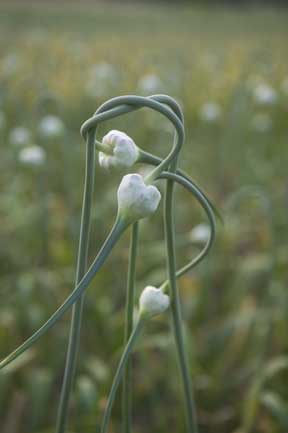Great scapes: Garlic stems proving as useful as bulb Spokesman-Review, June 2008 In early summer, when Hollywood turns to escapism, gardeners and cooks turn to plain old scape-ism. Garlic scapes are those curlicued green stems that shoot up from garlic plants in mid-to-late June. A few years ago, hardly anybody in America bothered to cook them, although Asian and Italian cooks have used them forever. Recently, however, Americans have discovered that the scape is a mild, fresh spiral of spring-green goodness, delicious whether stir-fried, par-boiled, roasted, grilled or pureed into aromatic pesto. "It's like the new fiddlehead fern, the new morel, a new discovery," said MaryJane Butters of MaryJanesFarm near Moscow, Idaho. "It has the flavor of garlic, but not the heat, and it has this luscious green color." If you grow garlic in your garden, all you have to do is pop off those scapes while they're still new and tender – probably within the next week or three in our region. If you don't grow garlic, all you have to do is pop into a farmers' market, where you can usually find scapes for sale during a short window of opportunity, which usually closes just after the Fourth of July. The stems get tough and woody if they aren't picked shortly after they have formed. In our region, we're lucky to have two scape experts to fill us in on all things scape-ist. Foremost is Butters, who was an early and ardent advocate of scapes in her book, "MaryJane's Ideabook, Cookbook, Lifebook" and who sells scapes and scape products at her organic farm in Idaho. She gave this advice on how and when to harvest scapes from your garden: "I usually count on scapes about the third week of June, right when you can walk along and pop the stems off like asparagus," she said. "They'll pop off right about the spot where they're starting to get tough." Our second garlic expert is Ted Jordan Meredith, of Edmonds, Wash., whose new book, "The Complete Book of Garlic," is forthcoming in August from Timber Press. He said the typical practice – for those who want to balance scapes with maximum garlic-bulb production – is to harvest just after the scape curls downward and definitely before it uncurls and starts to straighten out. You'll find scapes only on hardneck garlic varieties. Most commercial varieties from California and points south are softnecks, but Northwest gardeners tend to gravitate toward hardneck varieties. Meredith pointed out that cutting scapes was always considered a good idea for horticultural reasons, even before people knew about their culinary charms. "If you let the scapes continue to grow, it will reduce the size of the garlic bulb," said Meredith. And once they're in your harvest basket, you've got yourself a grass-green bundle of pure, coiled potential. "You can stir-fry garlic scapes or you can sauté them and put them in omelets and scrambled eggs," said Butters. "Roasted, they're dynamite. Or you can boil them or bake them." Leave 'em whole for roasting, boiling or baking. Cut 'em into short lengths for stir-frying and sautéing, the way you would use asparagus. "My favorite way of using them is grilling them," said Meredith. "They usually coincide with the salmon season and salmon and scapes is one of our favorite things to do. You just sprinkle them with olive oil and salt – or toss them in a marinade – and put it on the grill. When it starts to heat up, it will start to wilt and you just turn it with tongs. I think it tends to have a little more flavor – browning it brings out the garlic flavor." Possibly the best and most practical use is Garlic Scape Pesto (see recipe below). That's one of Butters' favorites, because you can use it in so many ways, the way you would use regular basil pesto. "I love it spread on breads and stuff," said Butters. "I also take mine and turn it into a salad dressing." To make it into a salad dressing, all you have to do is thin out the pesto with some vinegar, lime juice and olive oil. The result is a fresh-scented, garlic-accented salad dressing without the full garlic bite. Butters is also partial to pesto because it's an ideal way to preserve scapes far beyond the June harvest. She said you can make the pesto with just enough liquid to hold it together – leaving out the parmesan cheese – and put it into zip-top bags and freeze it. Then, you can take it out, add the cheese and a little more olive oil and have that late-June flavor at Thanksgiving. And, yes, by the way, you should use the entire stalk, including the elegant white bud at the end. "I always use the white stuff," said Butters. "It's like eating the bud on a chive."
From "MaryJane's Ideabook, Cookbook, Lifebook" (Potter, 2005) 1/4 pound garlic scapes Puree garlic scapes and olive oil in a blender or food processor until smooth. Stir in parmesan cheese and lime juice and salt, to taste. Yield: 3 cups
From "MaryJane's Ideabook, Cookbook, Lifebook" 8 whole garlic scapes Preheat oven to 350 degrees. Place garlic scapes on foil and drizzle with olive oil. Bake for 20 minutes, or until scapes are softened. Yield: 2 servings
From "MaryJane's Ideabook, Cookbook, Lifebook" 1 1/2 cups garlic scapes, chopped Place garlic scapes and scallions in a 10-inch skillet with 1 teaspoon olive oil, the hot water and a pinch of salt. Cook, covered, over medium-high heat until tender, about five minutes. Drain well. Beat eggs with salt and pepper. Add remaining oil to skillet. When the oil is hot, shake the skillet to spread the greens evenly and add eggs. Cover and cook over medium-low heat until top is set (2 to 3 minutes). Cut into wedges; serve hot or cold. Yield: 2 servings
From "MaryJane's Ideabook, Cookbook, Lifebook" 10 whole garlic scapes Preheat oven to 350 degrees. Place garlic scapes on a sheet of foil and drizzle with 1 tablespoon of the olive oil. Fold in the edges to make a packet. Bake for 20 minutes or until scapes are softened. Puree in a food processor until smooth. Heat 2 tablespoons of olive oil over medium-high heat in a large sauté pan. Add the shallots and cook until soft. Add the rice and stir until lightly golden brown, about 3 to 4 minutes. Add 1 cup of the stock and cook until absorbed completely. Add enough chicken stock to cover risotto and stir until the liquid begins to be absorbed. Continue adding more stock to cover the rice until the risotto is tender to taste. Risotto should be creamy, but not soupy. Remove from heat. Add the scape puree, Parmesan cheese and butter, and stir to combine. Yield: 4 servings
|



